The tradition of the Mauracher Hof goes back for almost 2000 years. The medieval name 'Muron' ('on the walls') indicates that the Alemanni have found stone walls of a Roman estate. Remains of these walls, pottery and other finds were discovered in the 1970s. Ground radar measurements of the years 2010/11 detected the walls.
The existence of a Roman estate ('villa rustica') at the foot of the “Mauracher Berg” is stabilised by means of underground foundations. Two pieces of pottery (with Potter's mark) and a copper boiler, which were found here, allow a dating in the 2nd/3rd century. To what extent this Roman farm was destroyed after the Romans left in 260 A.D. And therefore left the territories east of the Rhine to the Alamanni can not be said for sure.
In the year 952 the Great Emperor Otto withdrew the village 'Muron' (later: Maurach) the Guntram count of the Breisgau and transferred it to the Bishop Konrad von Konstanz. A medieval courtyard in Maurach (”curtis in Muron”) is attested since the 12th century in many documents, often along with a church ('ecclesia'), that has probably been on the Eastern spur of the “Mauracher Berg”.
This medieval Court 'ze Mure' which used to be called 'ze Gloter' was Due to this it became the property of 'Constance justice' or even - after 1316 at the Church Pastor Johannes Waldener - make called ‘Waldeners Hof'.
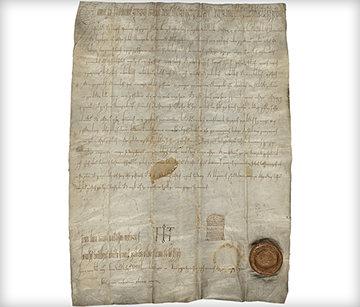
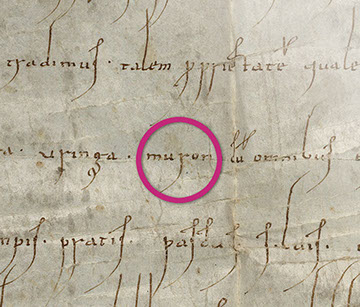
![]()
An excerpt from the deed of Emperor Otto the Great of the 21 February 962, mentions in the 'muron' for the first time. The location ('locus') was removed from the Count Guntram and given to the Bishop Konrad of Konstanz.


Als im Jahre 1972 bei Baumaßnahmen von der Südwestecke des Gasthauses aus in westlicher Richtung ein Kabelgraben gezogen wurde, sind an drei Stellen Gebäudemauern durchschnitten worden. Funde von Ziegeln und Scherben aus römischer Terra sigillata, die der ehrenamtlich tätige Archäologe Josef Schneider damals sicherstellte, erlauben eine Datierung der Gebäude in die Zeit des 2. und 3. Jh. Denn ein Töpfer namens Vindemialus, dessen Name auf der Innenseite einer Gefäßscherbe eingestempelt ist, war, wie wir durch die Datierung von vergleichbaren Töpferwaren wissen, um 150 n. Chr. in der Gegend von Bergzabern (nordwestlich von Karlsruhe) tätig.
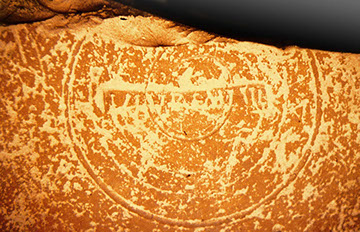
Abb.: Diese Terra-sigillata-Scherbe aus dem 2. Jh. n. Chr. mit dem Töpfer-Stempel VINDEMIALI wurde am Mauracher Hof gefunden.In der Niederung nördlich des heutigen Gehöftes förderte der Bagger unweit der Kläranlage ein zerdrücktes Kupfergefäß zutage, das ebenfalls in das 2. nachchristliche Jahrhundert gehören dürfte. Überall, wo im näheren Umkreis des Gasthauses Gräben gezogen wurden, etwa westlich der Scheune und vor dem Wohnhaus, stieß man seinerzeit auf Mauerreste, die als römisch erkennbar sind.
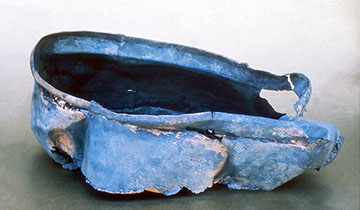
Abb.: Auch dieses römische Kupfergefäß entstammt vermutlich dem 2. Jh. n. Chr. Es wurde nördlich des Mauracher Hofes gefunden.Eine geophysikalische Prospektion, die in den Jahren 2010 und 2011 im Auftrag der Archäologischen Denkmalpflege (im Regierungspräsidium Freiburg) unter der Leitung von Florian Tränkle durchgeführt wurde, gab näheren Aufschluss über den Verlauf der Mauern, deren Fundamente noch unter der Erde liegen.
Demnach bestand die römische Gutshofanlage aus einer Umfassungsmauer, die auf einer Länge von 125 m nachgewiesen werden konnte, und mehreren Gebäuden, deren Grundrisse teilweise noch erkennbar sind. Außer einem großen, mehrräumigen Gebäudekomplex innerhalb des Mauracher Hofes (in der folgenden Abbildung: Nr. 1: Hauptgebäude) sind im Bereich des Schwimmbad-Parkplatzes mindestens zwei weitere Gebäude (in der folgenden Abbildung Nr. 3 und 4: Nebengebäude) erkennbar. Weitere Gebäude waren an der Umfassungsmauer (in der folgenden Abbildung Nr. 2) angebaut.
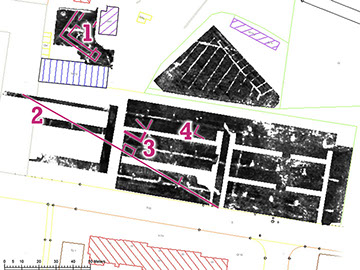
Abb.: Zeichnung (von Florian Tränkle) nach den geophysikalischen Messungen am Mauracher Hof 2010/2011.Wenn auch nur ein Teil dessen, was sich unter der Erde befindet, mit Hilfe des Bodenradars sichtbar gemacht werden konnte, lässt sich eine römerzeitliche villa mit einem großen Hauptgebäude und mehreren Nebengebäuden erkennen, die von einer langen Mauer umgeben sind. Nach Florian Tränkle „ist die villa vom Mauracher Hof eine der größeren Anlagen ihrer Art in der Region und in weiten Teilen offenbar noch gut im Boden erhalten“ (Tränkle S. 22).
Während der Baumaßnahmen in den 1970er Jahren wurden im gesamten Gebiet des Sportbads, beim Obsthof Haller, im Verlauf der Berliner Straße und nördlich des Mauracher Hofes Reste von Schmelzöfen und Schlackengruben zutage gefördert. Sie lassen den Schluss zu, dass am Südostabhang des Berges einst Eisenerz verarbeitet worden ist. Der dazu erforderliche Rohstoff dürfte vom Einbollen stammen, wo bis heute noch zahlreichen Gruben, sogenannte „Pingen“, sichtbar sind, in denen Erz abgebaut worden ist.
Die Eisenverarbeitung am Mauracher Berg lässt sich demselben Zeitraum zuweisen, dem auf Grund der Scherben mit Stempelpressung die Gebäude im Bereich des Mauracher Hofes angehören. Bei der chemischen Analyse eines Holzkohlenstücks aus einer der Verhüttungsgruben am Hof ergab sich eine Datierung in die Zeit um Christi Geburt (Josef Schneider).
 Autor dieses ArtikelsDieter Geuenich
Autor dieses ArtikelsDieter Geuenich Quellen / CopyrightsVideo: Animation, Illustration, Luftbild
Quellen / CopyrightsVideo: Animation, Illustration, Luftbild
Quelle: Medienhaus Denzlingen, Foto Patrick DirrUrkunde Kaiser Otto I. vom 21. Februar 962: Generallandesarchiv Karlsruhe, Signatur A40.Edition: Die Urkunden Konrad I., Heinrich I. und Otto I. (Conradi I., Heinrici I. et Ottonis I. Diplomata), herausgegeben von Theodor SICKEL (1879-1884, Nachdruck 1997) Nr. 236.Dieter GEUENICH, Denzlingen, eine alemannische Siedlung im Breisgau (Freiburg 1983).Dieter GEUENICH – Dieter OHMBERGER, Denzlingen, Band 1: Von den Anfängen bis zum Dreißigjährigen Krieg (Denzlingen 2013), S. 21-24 und S. 43-49.Josef SCHNEIDER, Fundbericht bei den Ortsakten des Landesdenkmalamtes im Regierungspräsidium Freiburg im Breisgau (zitiert in: GEUENICH, Denzlingen).Florian TRÄNKLE, Villa mit Schwarzwaldblick. Die römische Siedlung am Mauracher Hof bei Denzlingen. Archäologische Nachrichten aus Baden 85, 2012, 16–23. BuchempfehlungDie spannende Ortschronik der Gemeinde Denzlingen.Erhältlich bei
BuchempfehlungDie spannende Ortschronik der Gemeinde Denzlingen.Erhältlich bei
• Buchhandlung Losch
• Schreibwaren Markstahler
• Rathaus Denzlingen
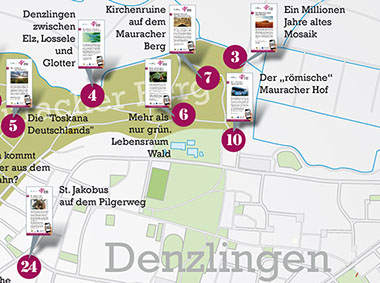






Für alle Geocacher
Display 10:
N 48° 04’ 27.3”
E 007° 54’ 03.8”Display 3:
N 48° 04' 39.3”
E 007° 53' 58.6”Display 4:
N 48° 04' 33.1”
E 007° 53' 40.2”Display 6:
N 48° 04‘ 32.5“
E 007° 53‘ 55.4“Display 7:
N 48° 04’ 35.0”
E 007° 54’ 00.7”Display 8:
N 48° 03’ 43.2”
E 007° 54’ 34.1”Display 9:
N 48° 03’ 44.6”
E 007° 54’ 45.8”Display 24:
N 48° 04' 13.0”
E 007° 53' 28.0”Display 25:
N 48° 04’ 28.4”
E 007° 55’ 22.2”

Für alle Geocacher die ganz genauen Positions-Daten:
Display 10:
N 48° 04’ 27.3”
E 007° 54’ 03.8”
























